December 21, 2009
A country and a continent
View Australia in a larger map
Here's one more look at our trip to Australia last month - through a map. Click the markers for blog entries and photos; if you've been following along, you won't find anything new but will be able to pinpoint our travels.
As you can see, Australia is a big place - a continent, as I've noted before. In two weeks, we covered just this small corner of the country. From Melbourne, at the center of the map, our route took us in a clockwise loop.
With so much more to see, we'll have to go back.
December 9, 2009
Back to the city
After spending the morning at Wilsons Promontory National Park, we made our way back to Melbourne for our last night in Australia. We spent the afternoon taking in a few final sights that we missed when we first arrived.
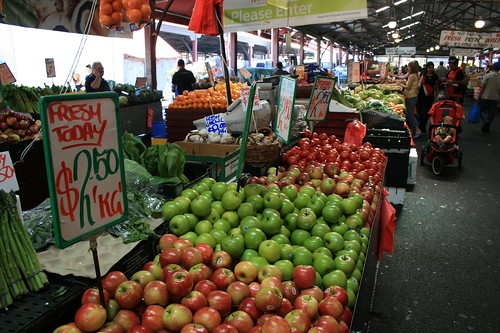
Queen Victoria Market is a massive covered complex just outside the central business district with numerous food stands and merchants selling trinkets, meats and produce. It would have been great to stock up on some fresh fruits and veggies at the start of our trip, but the market was closed the Monday we were in town.
A week and a half earlier, the Melbourne Cup horse race was the talk of the town. Now, the city was decked out for Christmas. (It was still a couple of weeks before Thanksgiving, but Australia doesn't have that holiday, of course.) The big Meyer department store downtown had it's animatronic window display up, decorations were strung high overhead the Bourke Street Mall, and trees and lights could be seen in many shops.
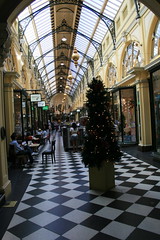
Before dinner, we also walked through the arcades tucked away just off the public mall. We had visited them previously, but all the shops were closed. This time, we were able to look around the stores.
After dinner, it was back to the hotel to pack up and get some sleep before the flight home.
The next morning, we had to hurry out of downtown as a Christmas parade would draw crowds and close streets. Once at the airport, it was only 25 hours to Missoula.
Find photos here.

Queen Victoria Market is a massive covered complex just outside the central business district with numerous food stands and merchants selling trinkets, meats and produce. It would have been great to stock up on some fresh fruits and veggies at the start of our trip, but the market was closed the Monday we were in town.
A week and a half earlier, the Melbourne Cup horse race was the talk of the town. Now, the city was decked out for Christmas. (It was still a couple of weeks before Thanksgiving, but Australia doesn't have that holiday, of course.) The big Meyer department store downtown had it's animatronic window display up, decorations were strung high overhead the Bourke Street Mall, and trees and lights could be seen in many shops.

Before dinner, we also walked through the arcades tucked away just off the public mall. We had visited them previously, but all the shops were closed. This time, we were able to look around the stores.
After dinner, it was back to the hotel to pack up and get some sleep before the flight home.
The next morning, we had to hurry out of downtown as a Christmas parade would draw crowds and close streets. Once at the airport, it was only 25 hours to Missoula.
Find photos here.
Going south
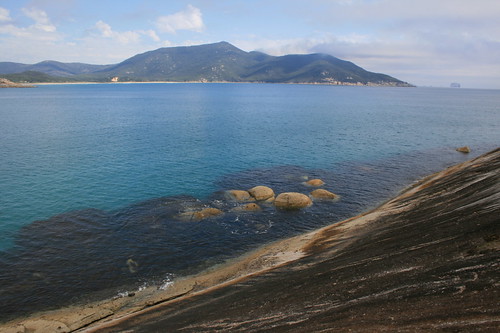
From the mountains, we drove downhill to Wilsons Promontory National Park - or "The Prom" - the southernmost point on mainland Australia.
Unfortunately, in planning our trip this stop was mostly an afterthought; we allotted only one night for our visit because we were trying to break up the drive from Alpine National Park to Melbourne before our departure. In hindsight, it would have been better to spend a full day at The Prom and cut our time in the high country by a day. We'll just have to come back.
Here, the rainforest meets the ocean and the trails are numerous, but we only managed a few short walks.
The afternoon we arrived, we set out from the visitor center at Tidal River, hiking around Norman Point to the white-sand beach at Little Oberon Bay. On the way back to our car, we paused on the trail to watch a stand-up paddler surf the waves of Norman Bay with a sweeping backdrop of ocean and islands.

On the way to our cottage outside the park for the night, we took one more quick walk, along the Lilly Pilly Gully track. Orchids were still blooming but past their peak along part of the trail burned by bushfire. And the flowering stalks of grass trees were a unique sight.
With the sun sinking and our stomachs empty, we turned around short. The next morning, we came back to complete the walk through the rainforest, and before leaving we also strolled out to an empty Darby Beach.
From here, it was an easy drive back to Melbourne for one final night in the city.
Pictures from The Prom are here and here.
Norman Point and Little Oberon Bay
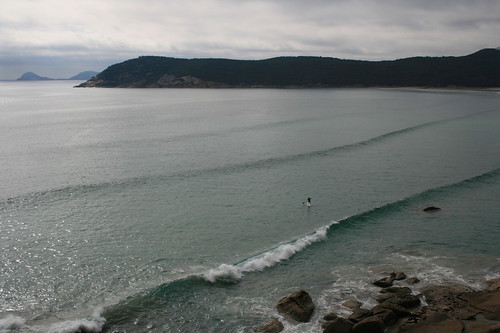
This trail wanders through the tea trees to the beach at Norman Bay, then up and around Norman Point, and back down to Little Oberon Bay. About halfway through, a short path detours down to the rocky cliffs on the point. There are plenty of views of surfers and islands.
Distance: 8.2 kilometers round trip.
Trailhead: Start at the visitor center in Tidal River, 29 kilometers south of the park entrance.
Lilly Pilly Gully Nature Walk

Walk through a bushfire area to a short boardwalk loop in the rainforest. The orchids and grass trees are beautiful.
Distance: 5.2 kilometers round trip.
Trailhead: The Lilly Pilly Gully carpark is about 26 3/4 kilometers south of the park entrance.
Darby Beach
A short, sandy walk to a beach where the Darby River meets the ocean.
Distance: 2.2 kilometers round trip.
Trailhead: The Darby River parking area is about 18 kilometers south of the park entrance.
December 7, 2009
Head for the hills
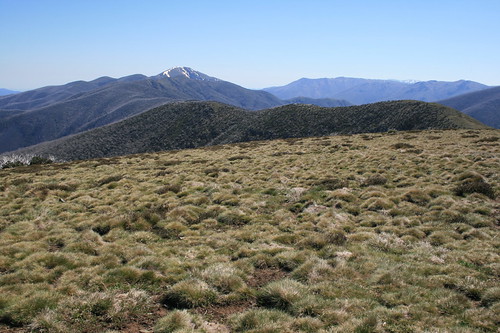
After a long day of driving east from Halls Gap, we arrived in Bright, our entry point to Alpine National Park.
When you hear "Alpine National Park" or "Australian Alps," your first thoughts are likely of tall, pointy peaks. The mountains here, however, aren't that tall or pointy. The highest is Mount Bogong at 1,986 meters, or about 6,516 feet - slightly taller than Mount Dean Stone on the southeast side of Missoula. And the summits are rounded, like many of the mountains around home. This is, however, a popular area for skiing - in fact, we saw some lingering snow on our walks.
I don't mean to belittle these mountains; they can still be a dangerous place, as evidenced by the rescue of a Victorian minister who fell during a snowy September walk to a peak we visited. The region also has been a bushfire hotspot of late, with big burns in 2003 and 2006.
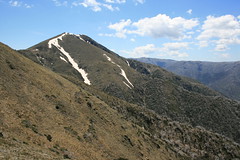
We spent our only full day in Bright driving to the top of the Great Alpine Road and walking out The Razorback to Mount Feathertop. The hike was pretty simple - a long, grassy ridge - but at 22 kilometers round trip, it was the longest and most uncrowded of our vacation. To cap off the full day out in the sun, we stopped at the Bright Brewery back in town to sip down a cool Razor Witbier.
The next day, we spent the morning walking to a couple of waterfalls in nearby Mount Buffalo National Park and the afternoon driving over the Great Alpine Road to Omeo, on the south side of the mountains.

From Omeo, we drove the Bogong High Plains Road - fully paved only a year earlier - up to Falls Creek for a day. Near here, we went on a couple of hikes, including along a short section of the 650-kilometer Australian Alps Walking Track.
After three days in the high country, we next headed for the coast again and Wilsons Promontory National Park, the southernmost part of mainland Australia.
Find all of our pictures here, here and here.
The Razorback to Mount Feathertop
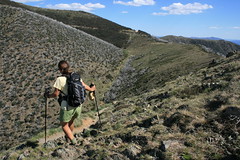
From just below the top of the Great Alpine Road, this trail follows a grassy ridge 11 kilometers out to the top of Mount Feathertop. The majority of the trees along this route were burned in bushfires, and as a result it was a very sunny and hot walk.
Distance: 22 kilometers round trip.
Trailhead: Follow the Great Alpine Road about 49 3/4 kilometers south and east to the pullout for the Diamantina Hut, 2 1/2 kilometers before reaching Mount Hotham. The trail begins across the road from the hut.
Ladies Bath Falls and Eurobin Falls

A short trail leads to a couple of picturesque waterfalls. The pool below Ladies Bath Falls is clear, cool and inviting, though we didn't take the time to dip our feet.
Distance: 1.5 kilometers round trip.
Trailhead: From Bright, take the Great Alpine Road 6 1/3 kilometers northwest to Porepunkah, then Mount Buffalo Road 6 kilometers to the Mount Buffalo National Park entrance. Continue about 2 2/3 kilometers to the pullout.
Rollasons Falls

This trail drops down to an upper and lower falls on Buffalo Creek. View the lower falls from the pool below and the upper falls from the drop-off above.
Distance: 2 kilometers round trip.
Trailhead: From Bright, take the Great Alpine Road 6 1/3 kilometers northwest to Porepunkah, then Mount Buffalo Road 6 kilometers to the Mount Buffalo National Park entrance. Continue about 8 3/4 kilometers to the pullout.
Mount Cope
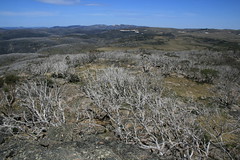
This trail leads up from the grassy plains, through trees to a rocky lookout.
Distance: 3 kilometers round trip.
Trailhead: From Omeo, drive 38 3/4 kilometers northwest on the Omeo Highway. Turn west on the Bogong High Plains Road and follow it about 22 kilometers to the pullout. The path begins across the road.
Australian Alps Walking Track
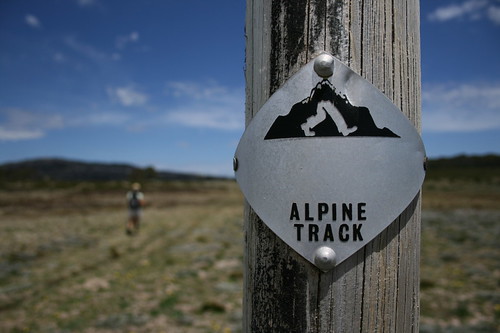
The AAWT is a 650-kilometer route across the mountains from Walhalla in Victoria to Tharwa, near Canberra in the Australian Capital Territory. We walked a short section of it from the Bogong High Plains Road to the Cope Saddle Hut and back. Numbered posts every 40 meters make it easy to follow the trail and calculate your distance.
Distance: 6.7 kilometers round trip.
Trailhead: From Omeo, drive 38 3/4 kilometers northwest on the Omeo Highway. Turn west on the Bogong High Plains Road and follow it about 24 kilometers to the pullout. Our route began across the road.
December 6, 2009
Road rules
The most frequent question we've received since our return from Australia has been some variation of, "Is it difficult driving on the left side of the road?"
The answer: Not really. Australia was, in fact, the second time in the past few years we've had to drive on the left side; we rented a car in Scotland a couple of years ago, too.
Sure, you frequently have to remind yourself that you need to be in the left lane when pulling out of a driveway first thing in the morning - and you may occasionally catch yourself trying to get into the right lane. And yes, the gas and brake pedals are backward.
But once you get going, it's not really that difficult. No matter which side of the road you're on, the driver is always in the middle.
The hardest part, for us at least, was signaling turns. The turn signal and windshield wiper levers are also reversed, and for some reason that tripped us up the most. It also was the hardest thing to readjust to when we returned home and started driving our own car.
The best piece of advice I received about driving on the left side was to rent an automatic. Cars with sticks can be cheaper, but with an automatic it's one less thing to worry about.
Fortunately, because we parked the car in Melbourne and walked or took the tram, we never encountered what appeared would be the biggest obstacle to driving in Australia: the "hook turn" in Melbourne. I won't even try to describe it, so here's a description.
The answer: Not really. Australia was, in fact, the second time in the past few years we've had to drive on the left side; we rented a car in Scotland a couple of years ago, too.
Sure, you frequently have to remind yourself that you need to be in the left lane when pulling out of a driveway first thing in the morning - and you may occasionally catch yourself trying to get into the right lane. And yes, the gas and brake pedals are backward.
But once you get going, it's not really that difficult. No matter which side of the road you're on, the driver is always in the middle.
The hardest part, for us at least, was signaling turns. The turn signal and windshield wiper levers are also reversed, and for some reason that tripped us up the most. It also was the hardest thing to readjust to when we returned home and started driving our own car.
The best piece of advice I received about driving on the left side was to rent an automatic. Cars with sticks can be cheaper, but with an automatic it's one less thing to worry about.
Fortunately, because we parked the car in Melbourne and walked or took the tram, we never encountered what appeared would be the biggest obstacle to driving in Australia: the "hook turn" in Melbourne. I won't even try to describe it, so here's a description.
November 30, 2009
Rocks and 'roos
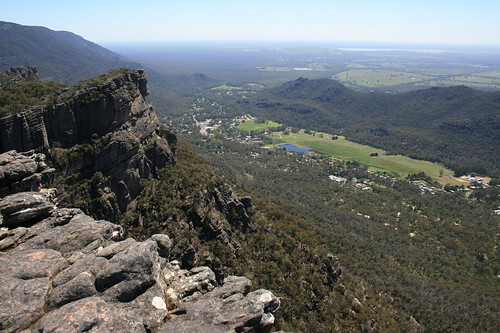
The next leg of our journey through Australia brought us inland to Halls Gap and Grampians National Park, known for its rugged bushwalking, waterfalls and wildflowers. Then there are the kangaroos.
We selected D'Altons Resort as our accommodation in Halls Gap based on the recommendation of Lonely Planet's guide to Australia and the price. Plus, the guidebook mentioned kangaroos and the resort's Web site featured pictures of the animals - both turned out to be accurate.
The evening we arrived, we spotted the first kangaroos of our trip, just off our cottage's front porch on the lawn. The next morning, while sipping coffee and looking out the front window, a line of eight bounced up from our driveway, across the grass and into the trees. Like clockwork, they would return every morning and evening.
(Really, you're likely to see kangaroos anywhere you stay in Halls Gap. And cockatoos. They're everywhere.)
That first morning, we had planned a good day of hiking but decided to try our luck with wildlife on a quick walk near the park's visitor center. Sure enough, we saw kangaroos here and there munching grass in the morning sun, as well as a few red deer. We also encountered something we hadn't expected: cold.
In our first few days in the country - the first few days of the month - the TV news had already said it was the warmest November on record since 1925. And it was quite a change from the early cold spell back in Missoula. We thought we'd never need them, but it was a good thing we packed warm coats and gloves - that walk was a chilly one. It quickly warmed up, though, and we hit the trail on the first real hike of our holiday.
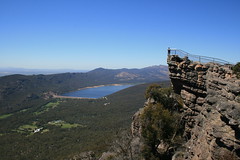
A few hundred meters up the road from our cottage, we set out on the Wonderland Loop. The track follows a creek behind town, then climbs up through rocky mountains before topping out at The Pinnacle, an outcrop above Halls Gap. From there, it descends the face of the mountains back into town. Along the way, we saw plenty of wildflowers remaining from the spring bloom - the result of bushfires throughout the area in 2006. (While there were still plenty of blackened trees, the park appears to be recovering well, with plenty of green growth.)
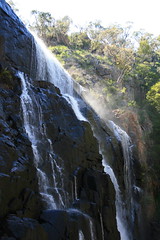
We spent the next day driving around the Grampians and taking shorter strolls to see waterfalls and scenic overlooks. These included The Balconies, MacKenzie Falls, Lake Wartook, Silverband Falls and Mount William.
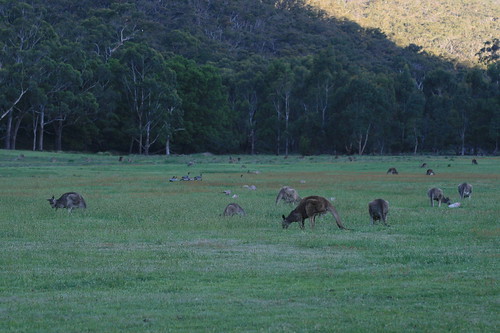
After dinner at the cottage that evening, we decided to check out the trail near the park visitor center again to snap a few more wildlife pictures. We hit the jackpot - a field filled with kangaroos big and small, eating and bouncing around. There were probably a couple of hundred or so, and we lingered for a while to watch.
The next morning, we departed early - we had a full day's drive east ahead of us, to Victoria state's high country and Alpine National Park.
See all of our pictures here and here.
Fyans Creek Loop
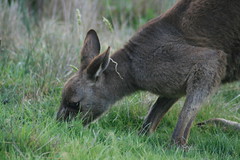
This short loop walk travels through the bush north along the west side of Fyans Creek, crosses a bridge, then travels south to a field, crosses another bridge and returns to the start. See kangaroos and red deer in the morning and evening.
Distance: 2.5-kilometer loop.
Trailhead: The walk begins and ends at Brambuk - The National Park and Cultural Center, off Grampians Tourist Road on the southern edge of Halls Gap.
Wonderland Loop

This trail was the highlight of our time in the Grampians. From the parking area, it follows Stony Creek behind town and past the Venus Baths - where the water flows though a series of pools and over smooth rocks - then climbs to Splitters Falls and the Wonderland parking area. Here, it ascends through the narrow-walled Grand Canyon, a great place to find some shade, and past Bridal Veil Falls and Silent Street to The Pinnacle, a lookout above Halls Gap. The trail then descends through the forest on the face of the mountains and back to town. (The only downside to this walk is there are many metal railings and steps that look out of place.)
Distance: 9.6-kilometer loop.
Trailhead: The trail begins and ends in the parking area across Grampians Tourist Road from the shops in Halls Gap.
The Balconies
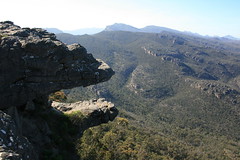
This easy walk travels out a rock outcrop with views north to Lake Wartook, then through the forest to a pair of ledges known as The Balconies.
Distance: 2 kilometers round trip.
Trailhead: From Halls Gap, follow Mount Victory Road 12 1/4 kilometers northwest and turn south on the access road. Drive two-thirds of a kilometer to the parking area.
MacKenzie Falls
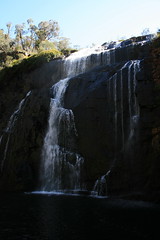
A path leads to overlooks and the base of MacKenzie Falls, a large cascade that, I gather, looks much more impressive when there's more water. (At one time a trail continued to the Zumstein picnic area, but the route was closed after bushfires.)
Distance: 2 kilometers round trip.
Trailhead: From Halls Gap, follow Mount Victory Road 17 1/4 kilometers northwest and turn north on the access road. Turn west at the T intersection and drive a short distance to the parking area.
Silverband Falls
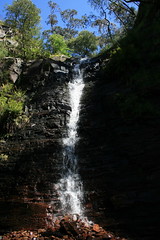
This trail travels through a fern forest to Silverband Falls, which cascades down a wall then disappears underground. We had good luck spotting cockatoos here, as well.
Distance: 1.4 kilometers round trip.
Trailhead: From Halls Gap, follow Mount Victory Road about 5 kilometers west and turn south on Silverband Road. Follow the road about 7 kilometers to the parking area.
Mount William
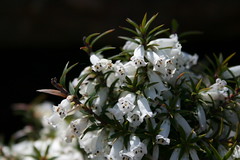
From the parking area, follow the closed road up to the top of 1,167-meter Mount William, the highest point in the Grampians. A lot of wildflowers were in bloom along the road when we visited, and the top provides expansive views west into the park and east out of the park.
Distance: 3.8 kilometers round trip.
Trailhead: From Halls Gap, follow Grampians Tourist Road about 12 1/4 kilometers south, then turn east on Mount William Road and drive about 9 1/2 kilometers east to the parking area.
November 27, 2009
To the beach
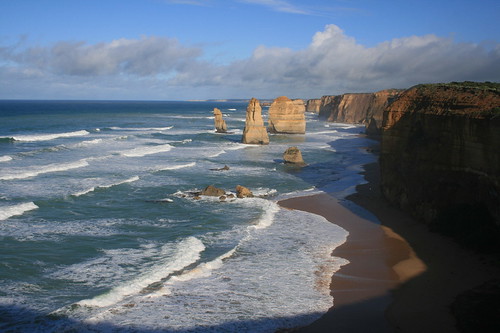
After a day in Melbourne, we set out west for the Great Ocean Road and Port Campbell. As you can tell from the pictures, it was a little cloudy with a few spots of sun. It was cool and rained a few times, but not really that bad.
The first stop on our journey was Split Point Lighthouse and Eagle Rock Marine Sanctuary at Aireys Inlet, where we stretched our legs with a short stroll down to the beach.
After that it was on to Lorne, where we took in views of the Great Ocean Road from Teddy's Lookout and went on a quick walk to Erskine Falls in Great Otway National Park.
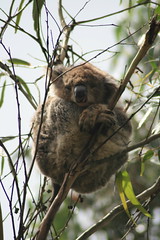
From Lorne, we followed the winding coastal route through Apollo Bay to Kennett River, where we got our first glimpse of Australian wildlife. On a recommendation, we walked a short distance up Grey River Road, spotting koalas napping in the branches of gum trees.
We continued on, driving up through the tree-covered hillsides and back down to the coast before reaching Port Campbell, our base for the next couple of days. Here, we would take in Port Campbell National Park, the site of numerous scenic sea stacks up to 70 meters tall.
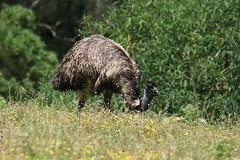
On the way to our next destination, we stopped at Bay of Islands Coastal Park to see more sea stacks and arches, and at Tower Hill State Game Reserve, just off the Great Ocean Road near Warrnambool, where we walked around an old volcanic crater and saw numerous emus.
The next leg of our journey would take us inland to Halls Gap and Grampians National Park, where the weather would heat up and the kangaroos would abound.
See pictures here and here.
Erskine Falls
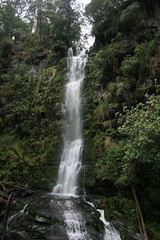
Follow the fern-lined trail and steps down to the base of Erskine Falls, one of many waterfalls near Lorne.
Distance: 700 meters round trip. (There's also a 15-kilometer round trip trail from Lorne to Erskine Falls.)
Trailhead: From Lorne, follow William Street and Erskine Falls Road about 8 1/2 kilometers out of town. Turn right and follow the access road about 1 1/2 kilometers downhill to the trailhead.
Twelve Apostles
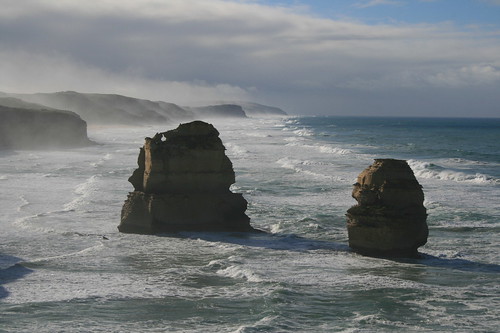
A path leads under the highway and out a boardwalk to overlooks of the Twelve Apostles, limestone sea stacks off the coast at Port Campbell National Park.
Distance: 1 kilometer round trip.
Trailhead: Follow the Great Ocean Road 10 3/4 kilometers east of Port Campbell to the Twelve Apostles Visitor Centre.
Loch Ard Gorge
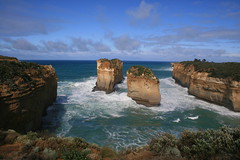
More sea stacks, as well as access to the beach below the cliffs, the Blowhole, Thunder Cave and Broken Head.
Distance: Three trails range from 900 meters to 3 1/4 kilometers round trip.
Trailhead: Follow the Great Ocean Road 7 1/4 kilometers east of Port Campbell to the parking area.
Gibson Steps
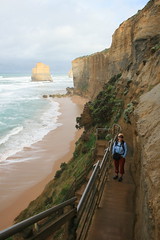
Steps were carved down the limestone cliffs to the beach in the 19th century. They're concrete now.
Distance: Unknown; negligible.
Trailhead: Follow the Great Ocean Road 11 3/4 kilometers east of Port Campbell to the parking area.
The Arch
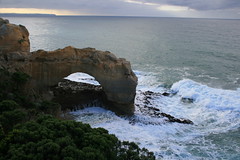
The Arch is pretty self-explanatory - an arch from the cliffs to the sea.
Distance: 280 meters round trip.
Trailhead: The Arch is 6 kilometers west of Port Campbell on the Great Ocean Road.
London Bridge
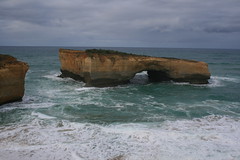
London Bridge used to be a double arch, but one side collapsed.
Distance: 200 meters round trip.
Trailhead: London Bridge is 7 kilometers west of Port Campbell on the Great Ocean Road.
The Grotto
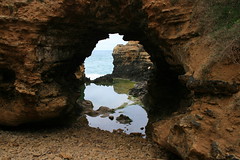
The Grotto is another arch, up off the ocean.
Distance: 680 meters round trip.
Trailhead: The Grotto is 8 2/3 kilometers west of Port Campbell on the Great Ocean Road.
Bay of Islands
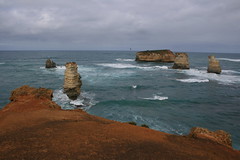
Bay of Islands has numerous sea stacks and arches.
Distance: 1.8 kilometers round trip.
Trailhead: Bay of Islands is 17 3/4 kilometers west of Port Campbell on the Great Ocean Road.
Tower Hill Reserve
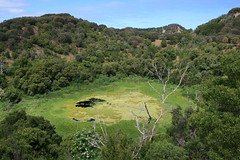
Tower Hill is a volcanic formation believed to have last erupted 32,000 years ago. Today, there are a handful of trails through and around old craters. We walked up and around a crater and saw several emus.
Distance: Unknown; probably a few kilometers.
Trailhead: From Warrnambool, follow the Princes Highway 12 kilometers west then turn north on the entrance road and take it 1 1/2 kilometers to the Worn Gundidj Visitor Centre.
November 20, 2009
Melbourne bound
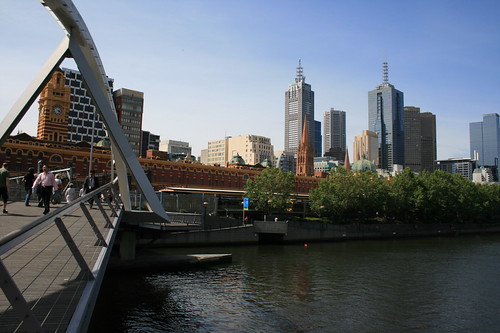
Our starting and ending point for our trip to Australia was the metropolis of Melbourne, which sits on the country's southern coast where the Yarra River lets out into Port Phillip Bay. The city itself has a population of just 90,000; including its 11 suburbs, that figure jumps to 3.9 million. Settled by Europeans in 1835, it is the capitol of Victoria state and Australia's second-largest city.
Why Melbourne? We bought our plane tickets during a fare sale on flights to Sydney and Melbourne. While Sydney has its famous opera house and bridge, we're not really city folk, as you can probably tell from this blog. On the recommendation of an extended family member from the area, we chose Melbourne for its access to national parks and bushwalking in the region.
After 31 hours of travel from Missoula - including a nine-hour layover in Denver - we arrived in Australia just after 10 a.m. Crossing the International Date Line jumped us ahead a day, but it went pretty smoothly, as I slept through most of the nearly 15-hour leg from Los Angeles to Sydney. (Australian airports are a little odd, though. It's almost as if you're funneled through a department store of duty-free items between your gate and customs.)
After touching down, we located our rental car - apparently Alamo isn't Alamo at the Melbourne airport; it's Europcar - and made our way to our hotel downtown. Once we were checked in and cleaned up, our adventure began.
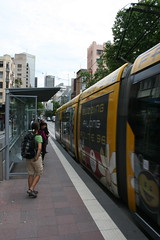
We spent our first afternoon getting oriented. Leaving the car behind, we bought tram tickets and a map. Downtown is a decent size but still very walkable, and the tram system makes it even more so. We made our way into the center of town, checking out City Square, Federation Square and the Yarra riverbank; looking in a few stores; and reading a few menus along the way. After some dinner at a local watering hole, we called it a night.
Melbourne has a heavy British influence - especially in some of the older buildings - as well as an Asian and Middle Eastern presence due to Australia's location on the globe. But I was surprised at how American it was downtown, mostly when it came to the retailers. McDonald's, Hungry Jacks (Burger King), Subway, Target. Granted, you probably won't find a foot-long chicken tikka sandwich in the United States.
Architecturally, the city has an old-meets-new feel: the spires of St. Paul's Cathedral across the street from the jaunty, metallic buildings on the edge of Federation Square; the Flinders Street Station dome vs. the modern, wavy roof of Southern Cross Station.
And Melbourne is a busy place, the trams and sidewalks packed with people during the workday. It doesn't let up after quitting time; people crowd the city's many cafes, restaurants and pubs, spilling out into sidewalk seating.
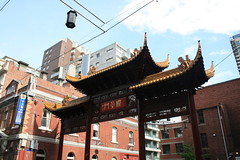
The next day, we set out early, starting with breakfast at a cafe around the corner from the hotel. Next, we hopped the tram up to the top of downtown and the Parliament House of Victoria. From there, we walked back down to the center of the city through Chinatown. We passed ornate archways at the start of each block, as well as a lot of food pictures and even some Peking ducks hanging in restaurant windows.
As we walked back toward Federation Square, we noticed people putting up barriers along one of the main streets. A worker told us a parade would be held in a couple of hours for the Melbourne Cup horse race, so we decided to return later. In the meantime, we took a relatively quiet stroll through the Royal Botanic Gardens on the other side of the Yarra, checking out the flowers.
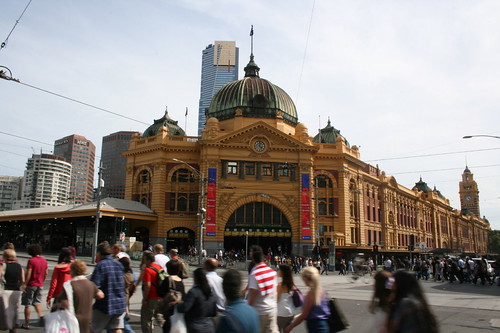
Back downtown, the crowd near Flinders Street Station had swelled with people from nearby office buildings as well as anti-horse-jumping protesters. The parade took place uninterrupted and featured past champion horses, current jockeys and other celebrities - think Olivia Newton John. As soon as the festivities were over, people clogged the streets on their way back to work.
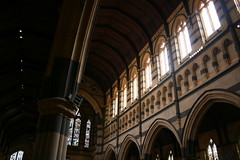
After lunch, we wandered a bit more, then took the free tram that loops downtown, traveling out to the to the high-rises of the formerly industrial Docklands and back up to Parliament. Next, we found our way to St. Paul's Cathedral for a look inside at its stained-glass windows and alternating rows of light and dark stonework.
After a quick trip back to the hotel to clean up, we grabbed some dinner at the James Squire brewery in the Portland Hotel, then picked up some groceries and turned in early for the night. The next day, we would set out on the Great Ocean Road west of Melbourne.
Find more pictures from Melbourne here and here.
November 15, 2009
Up from Down Under
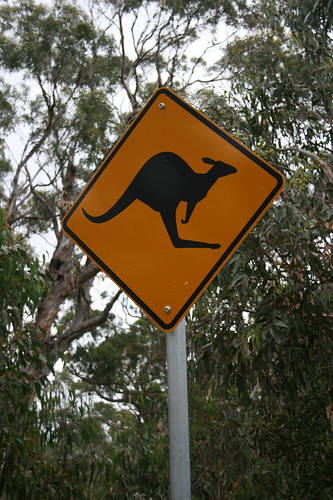
We're fresh back from two weeks in Australia, and in the interest of getting something posted fairly quickly I'm starting with some numerical odds and ends from our visit.
18,912: miles flown round trip from Missoula to Melbourne, with layovers in Denver, Los Angeles and Sydney. The longest leg was about 15 hours from L.A. to Sydney.
Oct. 31: Halloween, the day we didn't really see because of crossing the International Date Line. (We did get to carve pumpkins with our niece and nephew in the Denver area during a long layover on Oct. 30.)
Nov. 14: the day that seemed double, again due to crossing the International Date Line.
17: number of hours Melbourne is ahead of Missoula.
92: value of the American dollar in Australian cents at the time of our trip. We came out ahead even with foreign exchange and ATM fees.
One: the number of Australian states we visited - Victoria. Hey, it's a big country. A continent, in fact.
Six: the number of cities and towns we stayed in - Melbourne, Port Campbell, Halls Gap, Bright, Omeo and Yanakie.
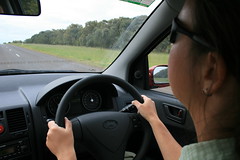
2,702: kilometers driven in our rental car. That's about 1,679 miles.
1.20: rough estimate of the average price we paid per liter of gas in Australian dollars. Equals about $4.18 per gallon in U.S. dollars. It cost more than $45 Australian to fill up.
6.80: price for a full-day tram ticket for Melbourne's central business district in Australian dollars. Downtown is extremely walkable, made even more so by the trams.
60, 80, 100 and 110: the most common speed limits we encountered, in kilometers per hour (about 37, 50, 62 and 68 in miles per hour). Sixty was normal in urban areas (occasionally it was 40 or 50 kph), 80 entering and leaving urban areas, 100 on most highways, and 110 on freeways.
Six: also the number of national parks we visited - Great Otway, Port Campbell, Grampians, Alpine, Mount Buffalo and Wilsons Promontory.
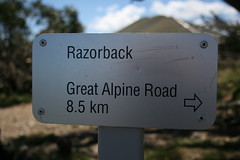
85: low estimate of the kilometers we walked in the bush; couldn't find distances for a few walks. That's almost 53 miles. Our longest outing was the 22K (13.7-mile) round trip out The Razorback to Mount Feathertop and back.
Four: number of mountains we walked up - The Pinnacle, Mount William, Feathertop and Mount Cope.
26 and 12: average high and low temperatures for our time in Victoria in Celsius (about 79 and 53 in Fahrenheit). By comparison, the high and low temperatures the day we returned to Missoula were 36 and 22 Fahrenheit (about 2 and minus 6 in Celsius).
30 and 70: SPF of sunscreens we wore. Still got probably the best tan of my life.
One: also the number of bushfires burning in areas we visited. Saw smoke from The Razorback.
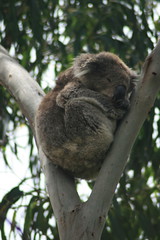
Five: the number of koalas we saw. Also saw a handful of emus, wallabies, kookaburras and rosellas, and too many kangaroos and cockatoos to count.

Two: the number of AC/DC references we saw in Melbourne - ACDC Lane and a poster of Angus Young advertising an art exhibit we never found.
Six: also the number of microbreweries we visited - James Squire in Melbourne, Flying Horse in Warrnambool, Halls Gap Brewery in Halls Gap, Tooborac Hotel and Brewery in Tooborac, Bright Brewery in Bright and Grand Ridge in Mirboo North. (Victoria is home to 35 of Australia's 120 microbreweries, according to "The Beer Lover's Guide to Victoria's Microbreweries.") Bright's Razor Witbier hit the spot after walking The Razorback out to Mount Feathertop. Six is also the number of bottles of craft beer that made it home to Missoula in our checked bags without breaking.
One: also the number of distilleries visited - Timboon Railway Shed in Timboon. Tasted five liqueurs. The Nocino green walnut-based liqueur is delicious.
One: also the number of wineries we visited - Heytesbury Ridge outside of Timboon. Tasted four wines.
One: also the number of cheesemakers we visited - Apostle Whey in Cooriemungle. Tasted 14 cheeses.
Zero: meat pies or pasties eaten. Sorry, vegetarians here. The vegetable roll at the High Plains Bakery in Omeo was great, though.
Of course, there was much more to our holiday than this, and more posts will be coming.
October 12, 2009
Prairie plunge
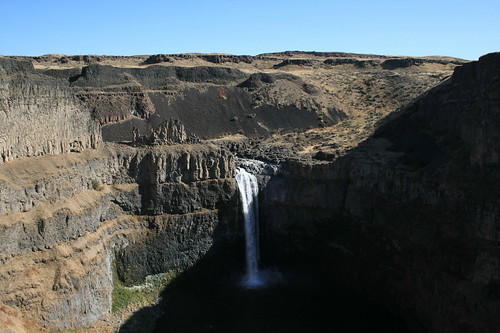
More travel, more celebration and more sights to see. Our stop at Palouse Falls State Park was more of a quick detour on the way home from the Tri-Cities in Washington, where we spent the weekend marking my grandmother's 90th birthday.
About 35 miles off the highway between Richland and Ritzville, the Palouse River gouges a canyon through the surrounding prairie and drops about 180 feet into a basalt bowl. Listen carefully, and you can hear the low rumble of the tumbling water before you see the falls.
A few pictures are here.
Distance: Several short paths are beaten along the canyon rim.
Trailhead: From Connell, Wash., drive 24 miles east on Highway 260. Turn southeast on Highway 261 and drive 8 3/4 miles to Palouse Falls Road. Turn northeast and follow the gravel road two miles to the state park parking lot.
October 4, 2009
Mapping our adventures
I recently updated the map of our trips - it now shows most everywhere we've been this year. It's always kind of interesting to see our travels from this perspective. Check back for more adventures!
October 2, 2009
Sunset on summer
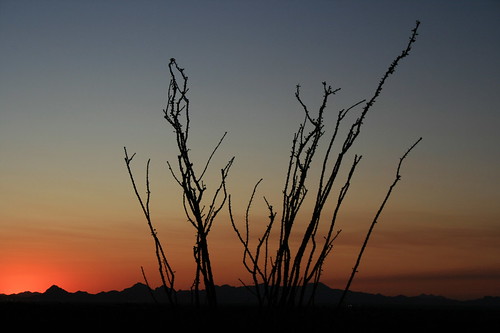
Last weekend, we got what will likely be our final glimpse of summer for the year while in Tucson, Ariz., for a wedding. There was plenty of sun, and temperatures in the city in the Sonoran Desert reached the high 90s and low 100s.
While we spent a good deal of time seeking the solace of air conditioning, we did manage to get out.
Our first excursion took us up into the Santa Catalina Range via the scenic Catalina Highway. The drive ascends 6,100 feet in 27 miles to the village of Summerhaven and Mount Lemmon, where the temperature was considerably cooler. Here, we took a hike through a fern, ponderosa pine and aspen forest in the Pusch Ridge Wilderness.
Later the same day, we took a short drive and walk through the Cactus Forest of Saguaro National Park's Rincon Mountain District. We timed our visit to see the sun sink in the sky to the west, pictured above, and the moon rise in the east.
The next morning, as we drove to the airport, we stopped in Saguaro's Tucson Mountain District to view some petroglyphs.
The trip was quick and there's more to see, so we'll be returning - albeit when it's cooler. And congrats to the newlyweds!
Marshall Gulch-Aspen Trail, Santa Catalina Range
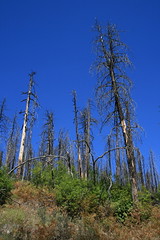
The trail begins by following Marshall Gulch west through a ponderosa pine forest, parts of which were burned in a 2003 wildfire. At about 1 1/4 miles, the route connects with the Aspen Trail, turning southeast. Just uphill from the junction are views of the Wilderness of Rocks and Tucson. The trail turns east, then north, traveling 2 1/2 miles though through more burn areas, a forest carpeted with ferns and aspen stands before returning to the trailhead.
See photos here.
Distance: 3.7-mile loop.
Trailhead: Drive 26 miles north and west up the Catalina Highway from northeast Tucson to Summerhaven. Follow the road one mile through the village to the Marshall Gulch Picnic Area. The Marshall Gulch trail begins next to the restroom.
Cactus Forest Scenic Loop Drive, Saguaro National Park
On the east edge of Tucson, the Cactus Forest Loop makes for a quick escape. Several trails are located along the paved road, including a fairly level 2.5-mile path that bisects the loop north to south. We arrived with enough time to hike out this trail a short distance and back before staking out a place along to road to watch the sun go down.
See photos here.
Distance: 8-mile loop drive, 5-mile round-trip hike. (We only hiked a short portion of this trail.)
Trailhead: On the east side of Tucson, follow the signs from Old Spanish Trail to the entrance of Saguaro's Rincon Mountain District. The Cactus Forest Scenic Loop Drive begins just past the visitor center. Cactus Forest trailheads are located on the north and south sides of the loop, roughly one-quarter and three-quarters of the way through the drive.
September 10, 2009
Mount St. Helens or bust
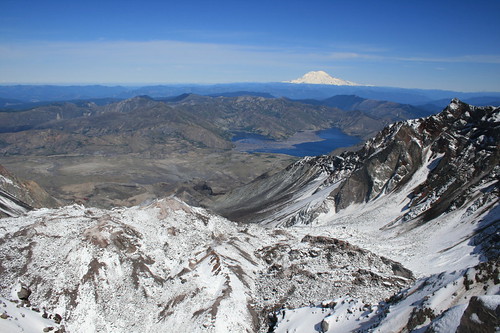
Seven months ago, Jen and I bought permits to hike up Mount St. Helens in southern Washington on Labor Day. Little did we know it would be raining all weekend. Fortunately, there were still permits available for the next day and the forecast was for clear skies.
After spending the long weekend waiting out the weather with relatives in Portland, Ore., we rose early on the morning of our hike and drove to Cougar, Wash., to pick up our permits and sign the register at the Lone Fir Resort. From there it was a quick drive to the trailhead at Climbers Bivouac.
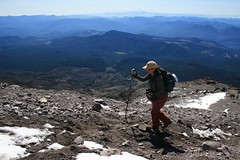
The route up Mount St. Helens is fairly steep, ascending about 4,500 feet in five miles. The first two miles are on a shady trail that rises about 1,000 feet through the forest to timberline. Once out of the woods, the real work begins as the hike climbs 3,500 feet over three miles to the crater rim. The trail fades and becomes rough as you scramble Monitor Ridge's boulder fields, following wooden posts about two miles and 2,200 feet up. The final mile and 1,300 feet of elevation gain are through loose pumice, ash and, in our case, snow from the previous days' storms. The powder wasn't much of a problem - there was only a few inches and earlier hikers had pretty much cleared a path to the crater rim.
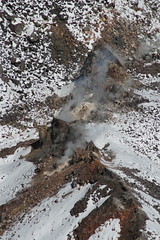
From the rim, you look about 2,000 feet down on the steaming lava dome. To the north are Spirit Lake and Mount Rainier. The peaks of North Cascades National Park stand to the northeast, Mount Adams to the east and Mount Hood to the south.
After spending about 45 minutes at the top snapping pictures and eating lunch, we made our way down. The descent went much quicker, as it was easier to navigate the boulders by looking down from above. After returning to Cougar to sign out, we sped back to Portland, arriving in time for dinner.
Permits are required year-round for hiking above 4,800 feet on Mount St. Helens; only 100 are issued each day from May 15 to Oct. 31. The Mount St. Helens Institute has more information, including the fee structure. Check permit availability here.
See pictures from our trip here and here.
Distance: About 10 miles round trip.
Trailhead: Climbers Bivouac is about 14 miles northeast of Cougar, Wash. Drive about 6 1/2 miles east of Cougar on Highway 503 and Forest Road 90. Turn northwest on Forest Road 83 and follow it about three miles to Forest Road 81. Turn northwest on FR81 and drive two miles. Turn northeast on Forest Road 830 and continue 2 1/2 miles to the trailhead. All but the final 2 1/2 miles are paved.
Subscribe to:
Posts (Atom)